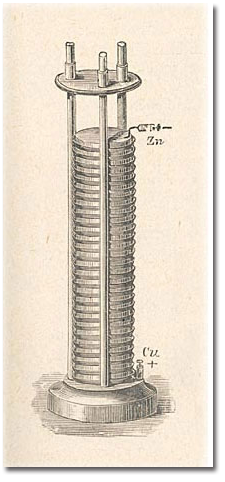Galvani and Volta
 In 1786, Luigi Galvani, an Italian professor of medicine, found that when the leg of a dead frog was touched by a metal knife, the leg twitched violently. Galvani thought that the muscles of the frog must contain electricity.He concluded that the twitching was evidence for the existence of animal electricity.''By 1792 another Italian scientist, Alessandro Volta, disagreed: he realized that the main factors in Galvani's discovery were the two different metals - the steel knife and the tin plate - upon which the frog was lying. In 1786, Luigi Galvani, an Italian professor of medicine, found that when the leg of a dead frog was touched by a metal knife, the leg twitched violently. Galvani thought that the muscles of the frog must contain electricity.He concluded that the twitching was evidence for the existence of animal electricity.''By 1792 another Italian scientist, Alessandro Volta, disagreed: he realized that the main factors in Galvani's discovery were the two different metals - the steel knife and the tin plate - upon which the frog was lying.
Volta showed that when moisture comes between two different metals, electricity is created. This led him to invent the first electric battery, the voltaic pile, which he made from thin sheets of copper and zinc separated by moist pasteboard.
In this way, a new kind of electricity was discovered, electricity that flowed steadily like a current of water instead of discharging itself in a single spark or shock. Volta showed that electricity could be made to travel from one place to another by wire, thereby making an important contribution to the science of electricity. The unit of electrical potential, the Volt, is named after Volta . It will be smart of you to think of electricity like water flowing in a pipe. The amount of water or mass is called volts, while its rate of flow is called amps, or like water's pounds per square inch. The old saying in medical electronics is volts shock, but amps kill.
As electrons bounce along through the wire, the general charge drift constitutes the current. The average, or drift, speed is defined as the speed the electrons would have if all were moving with constant velocity parallel to the field. The drift speed is actually small even in good conductors. In a 1.0-mm-diameter copper wire carrying a current of 10 amps at room temperature, the drift speed of the electrons is 0.2 mm per second. Yet, in copper, the electrons rarely drift faster than one hundred-billionth the speed of light.
|